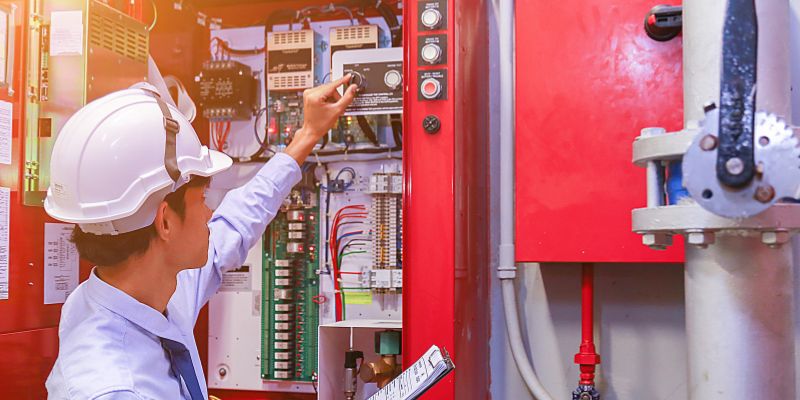Fire alarm systems are responsible for monitoring the fire safety equipment in a building and alerting people when it is ready. Fire alarms sound when there is a threat of smoke or flames, but supervisory alerts serve a different purpose. While these alerts do not mean that there is a fire, they do indicate that something in the fire safety system is faulty. These alerts are important because they allow maintenance and repairs to be made before a problem actually occurs. Building owners, property managers, and security personnel who are responsible for fire safety compliance and reliable system operation should be aware of these alerts.
Supervisory vs. Alarm Alerts
People often confuse supervisory and alarm alerts, which is a big mistake when it comes to fire safety. An alarm that sounds usually means that there is a fire hazard and that the fire department should be called. Supervisory alerts, on the other hand, mean that there is a problem or change in a part of the fire safety system that needs to be fixed, but it does not mean that everyone should evacuate immediately. Distinguishing between these two signals ensures that the system is functioning properly and prevents people from panicking for no reason.
Valve tampering signals
Valve tampering alarms are one of the most common alarms that supervisors receive. Alarms sound when a control valve in a water system is (partially) closed. This can be due to unauthorized access, unintentional misoperation, or planned repairs that have not been properly recorded. Monitoring systems quickly alert operators to closed valves, which can cause the sprinkler system to fail during a fire. Maintenance personnel can see the signal and ensure that the valve is reopened as soon as possible. Failure to pay attention to such signals can result in the system failing in an emergency.
Insufficient air flow in dry systems
Compressed air or nitrogen prevents water from entering the pipes of a dry sprinkler system until a fire breaks out. A drop in air pressure is often used as a warning signal for such systems. This can indicate a slow leak, a damaged compressor, or a damaged pipe network. If the air pressure is too low, the system can fail unexpectedly, causing the pipes to overflow or the system to fail. This warning is important for locations with dry systems, especially in cold regions, where water-filled pipes can freeze and burst.
Low or High Water Level in Tanks
Fire suppression systems often rely on water in tanks to provide sufficient pressure in an emergency. Monitoring warnings are issued when the water level in the tank is below or above a safe level. A low water level can indicate a leak, a problem with the refill system, or someone using the tank without permission. On the other hand, a high water level can indicate a faulty sensor or an overfilled or overflow tank, which can cause damage. Keeping track of the amount of water in the tank ensures that there is always enough water to fight a fire.
Fire Pump Failure or Operation
Fire pumps are essential for maintaining water pressure in high-rise buildings or other locations where water flow is restricted. A control signal can mean that a fire pump has started when it shouldn’t have, or that it didn’t start during a test or emergency. A pump starting unexpectedly can cause unnecessary wear and tear and maintenance issues. If the system doesn’t start, it may not function properly during an actual fire. These signals can help technicians pinpoint where the problem lies, whether it’s the electrical system, the motor, or the machine itself.
Loss of Power in the Fire Alarm Network
A fire alarm system that loses power is virtually useless. When the system detects a power outage, a failed backup battery, or a circuit rupture, it sends monitoring information. This type of information is important because it affects the central nervous system of the fire safety infrastructure. Electrical faults, blown circuit breakers, or faulty wiring can all cause power outages. If you respond quickly to this alert, the fire alarm system will resume operation so it can monitor for potential future problems.
Control Circuit Fault Signal
The control circuits in most fire alarm control panels continually monitor the status of other components. If the circuit has an open circuit, earth leakage or short circuit, a fault or control signal is generated. This signal does not indicate exactly what caused the fault, but it does indicate
Fault
The sprinkler’s water flow switch is responsible for detecting the flow of water into the system when the sprinkler is turned on. However, if this switch is damaged or installed in the wrong position, it may not work or may give an incorrect signal. When the system detects that the water flow switch is open, closed, or not working properly, it sends out a monitoring signal. Even if this warning does not mean an emergency, it is necessary to immediately check whether the sprinkler system is working properly in the event of a fire.
Communication problems with the central station
Today, fire alarm and monitoring systems are often connected to external monitoring systems, which send alarms and monitoring signals to fire departments and building management departments. When communication with the central station is lost, a monitoring signal that cannot be ignored is sent. Problems with the internet or cell phone signal, interference with the telephone line, or damaged communication equipment are all possible causes of this situation. This signal is very important for the safety of the building, because even a properly functioning fire alarm system may not be able to send an emergency signal in the event of an emergency without this signal.
Resetting and recording monitoring signals
After the monitoring situation has been resolved, the signal in the system must be cleared or restarted. Fire alarm control panels are commonly used for this purpose. Even after resetting, the information remains stored in the system. Most panels record everything the monitor does and sees. This helps with audits, inspections, and repair planning. A complete record of monitor events proves that fire safety regulations are being followed and that the building is being safely operated.
Responding to monitoring signals
A quick and informed response is essential for properly handling fire alarm signals. All management alarms should be investigated by a trained professional, such as a licensed firefighter or facility technician. Simple repairs, such as opening a valve or replacing a monitor, may need to be performed immediately. More complex cases may require expert repairs and diagnostics. The most important thing is not to ignore monitoring signals or treat them as minor issues. Each signal means that there may be a vulnerability in the fire protection system that, if not addressed quickly, could compromise safety.
In summary
To ensure that your fire protection system is always ready and functioning reliably, fire monitoring signals are essential. Even if these alarms do not mean that a fire has broken out, they do warn of problems that could shut down the system in a real emergency. Many monitoring signals can give us important information about the health of your fire safety infrastructure. These signals include tamper switches, tank water levels, fire pump alarms and power outages. Understanding what these signals mean and responding appropriately is essential to keeping your premises safe, saving lives and complying with fire safety regulations. Monitoring signals combined with proactive tracking and repairs are extremely useful in preventing problems and being prepared.

